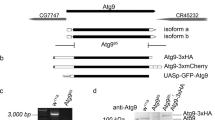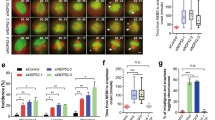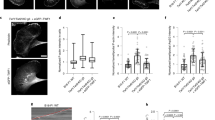Abstract
The actin-nucleation factors Spire and Cappuccino (Capu) regulate the onset of ooplasmic streaming in Drosophila melanogaster1,2,3,4,5. Although this streaming event is microtubule-based, actin assembly is required for its timing. It is not understood how the interaction of microtubules and microfilaments is mediated in this context. Here, we demonstrate that Capu and Spire have microtubule and microfilament crosslinking activity. The spire locus encodes several distinct protein isoforms (SpireA, SpireC and SpireD). SpireD was recently shown to nucleate actin, but the activity of the other isoforms has not been addressed. We find that SpireD does not have crosslinking activity, whereas SpireC is a potent crosslinker. We show that SpireD binds to Capu and inhibits F-actin/microtubule crosslinking, and activated Rho1 abolishes this inhibition, establishing a mechanistic basis for the regulation of Capu and Spire activity. We propose that Rho1, cappuccino and spire are elements of a conserved developmental cassette that is capable of directly mediating crosstalk between microtubules and microfilaments.
This is a preview of subscription content, access via your institution
Access options
Subscribe to this journal
Receive 12 print issues and online access
$209.00 per year
only $17.42 per issue
Buy this article
- Purchase on Springer Link
- Instant access to full article PDF
Prices may be subject to local taxes which are calculated during checkout





Similar content being viewed by others
References
Theurkauf, W. E. Premature microtubule-dependent cytoplasmic streaming in cappuccino and spire mutant oocytes. Science 265, 2093–2096 (1994).
Manseau, L. & Schüpbach, T. cappuccino and spire: two unique maternal-effect loci required for both the anteroposterior and dorsoventral patterns of the Drosophila embryo. Genes Dev. 3, 1437–1452 (1989).
Emmons, S. et al. cappuccino, a Drosophila maternal effect gene required for polarity of the egg and embryo, is related to the vertebrate limb deformity locus. Genes Dev. 9, 2482–2494 (1995).
Wellington, A. et al. Spire contains actin binding domains and is related to ascidian posterior end mark-5. Development 126, 5267–5274 (1999).
Cooley, L. & Theurkauf, W. E. Cytoskeletal functions during Drosophila oogenesis. Science 266, 590–596 (1994).
Palacios, I. M. & St Johnston, D. Kinesin light chain-independent function of the Kinesin heavy chain in cytoplasmic streaming and posterior localisation in the Drosophila oocyte. Development 129, 5473–5485 (2002).
Serbus, L., Cha, B., Theurkauf, W. & Saxton, W. Dynein and the actin cytoskeleton control kinesin-driven cytoplasmic streaming in Drosophila oocytes. Development 132, 3743–3752 (2005).
Manseau, L., Calley, J. & Phan, H. Profilin is required for posterior patterning of the Drosophila oocyte. Development 122, 2109–2116 (1996).
Magie, C. R., Meyer, M. R., Gorsuch, M. S. & Parkhurst, S. M. Mutations in the Rho1 small GTPase disrupt morphogenesis and segmentation during early Drosophila development. Development 126, 5353–5364 (1999).
Aktories, K., Wilde, C. & Vogelsgesang, M. Rho-modifying C3-like ADP-ribosyl-transferases. Rev. Physiol. Biochem. Pharmacol. 152, 1–22 (2004).
Quinlan, M., Heuser, J., Kerkhoff, E. & Mullins, R. Drosophila Spire is an actin nucleation factor. Nature 433, 382–388 (2005).
Brand, A. H., Manoukian, A. S. & Perrimon, N. Ectopic expression in Drosophila. Methods Cell Biol. 44, 635–654 (1994).
Wen, Y. et al. EB1 and APC bind to mDia to stabilize microtubules downstream of Rho and promote cell migration. Nature Cell Biol. 6, 820–830 (2004).
Palazzo, A. F., Cook, T. A., Alberts, A. S. & Gundersen, G. G. mDia mediates Rho-regulated formation and orientation of stable microtubules. Nature Cell Biol. 3, 723–729 (2001).
Wittmann, T. & Waterman-Storer, C. M. Cell motility: can Rho GTPases and microtubules point the way? J. Cell Sci. 114, 3795–3803 (2001).
Wallar, B. J. & Alberts, A. S. The formins: active scaffolds that remodel the cytoskeleton. Trends Cell Biol. 13, 435–446 (2003).
Evangelista, M., Zigmond, S. & Boone, C. Formins: signaling effectors for assembly and polarization of actin filaments. J. Cell Sci. 116, 2603–2611 (2003).
Zigmond, S. H. Formin-induced nucleation of actin filaments. Curr. Opin. Cell Biol. 16, 99–105 (2004).
Magie, C. R., Pinto-Santini, D. & Parkhurst, S. M. Rho1 interacts with p120ctn and α-catenin, and regulates cadherin-based adherens junction components in Drosophila. Development 129, 3771–3782 (2002).
Li, F. & Higgs, H. N. The mouse formin mDia1 is a potent actin nucleation factor regulated by autoinhibition. Curr. Biol. 13, 1335–1340 (2003).
Ishizaki, T. et al. Coordination of microtubules and the actin cytoskeleton by the Rho effector mDia1. Nature Cell Biol. 3, 8–14 (2001).
Higgs, H. N. Formin proteins: a domain-based approach. Trends Biochem. Sci. 30, 342–353 (2005).
Olson, M. F. GTPase signalling: new functions for diaphanous-related formins. Curr. Biol. 13, R360–R362 (2003).
Miller, A. L., Wang, Y., Mooseker, M. S. & Koleske, A. J. The Abl-related gene (Arg) requires its F-actin-microtubule cross-linking activity to regulate lamellipodial dynamics during fibroblast adhesion. J. Cell Biol. 165, 407–419 (2004).
Schumacher, N., Borawski, J. M., Leberfinger, C. B., Gessler, M. & Kerkhoff, E. Overlapping expression pattern of the actin organizers Spir-1 and formin-2 in the developing mouse nervous system and the adult brain. Gene Expr. Patterns 4, 249–255 (2004).
Leader, B. et al. Formin-2, polyploidy, hypofertility and positioning of the meiotic spindle in mouse oocytes. Nature Cell Biol. 4, 921–928 (2002).
Ryley, D. et al. Characterization and mutation analysis of the human FORMIN-2 (FMN2) gene in women with unexplained infertility. Fertil. Steril. 83, 1363–1371 (2005).
Spradling, A. C. P element-mediated transformation in: Drosophila, A Practical Approach (ed. D. B. Roberts) 175–197 (IRL Press, Oxford, 1986).
Grieder, N. C., de Cuevas, M. & Spradling, A. C. The fusome organizes the microtubule network during oocyte differentiation in Drosophila. Development 127, 4253–4264 (2000).
Cha, B. -J., Serbus, L. R., Koppetsch, B. S. & Theurkauf, W. E. Kinesin I-dependent cortical exclusion restricts pole plasm to the oocyte posterior. Nature Cell Biol. 4, 592–598 (2002).
Acknowledgements
We thank J. Infante, J. Nance, S. Parks, T. Phippen, J. Priess, P. Soriano and V. Vasioukhin for their advice and interest during the course of this work and for comments on the manuscript. We also thank C. Berg, L. Cooley, A. Ephrussi, B. Kaiser, A. Koleske, P. Lasko, M. Maurer, L. Manseau, H. Oda, J. Roe, S. Roth, T. Schüpbach, L. Serbus, D. St. Johnston, R. Strong, W. Theurkauf, T. Tsukiyama, J. Vazquez, V. Vigdorovich, A. Wittinghofer and the Bloomington Stock Center for advice, equipment, protocols, antibodies, DNAs, flies and other reagents used in this study. This work was supported by a National Institutes of Health grant (GM066847, to S.M.P.).
Author information
Authors and Affiliations
Corresponding author
Ethics declarations
Competing interests
The authors declare no competing financial interests.
Supplementary information
Supplementary Information
Supplementary Figures S1, S2, S3, S4, S5 and S6 (PDF 1413 kb)
Supplementary Information
Supplementary Movie 1 (MOV 1330 kb)
Supplementary Information
Supplementary Movie 2 (MOV 618 kb)
Supplementary Information
Supplementary Movie 3 (MOV 2173 kb)
Supplementary Information
Supplementary Movie 4 (MOV 2700 kb)
Supplementary Information
Supplementary Movie 5 (MOV 2049 kb)
Supplementary Information
Supplementary Movie 6 (MOV 712 kb)
Rights and permissions
About this article
Cite this article
Rosales-Nieves, A., Johndrow, J., Keller, L. et al. Coordination of microtubule and microfilament dynamics by Drosophila Rho1, Spire and Cappuccino. Nat Cell Biol 8, 367–376 (2006). https://doi.org/10.1038/ncb1385
Received:
Accepted:
Published:
Issue Date:
DOI: https://doi.org/10.1038/ncb1385
This article is cited by
-
Analysis tools for single-monomer measurements of self-assembly processes
Scientific Reports (2022)
-
Mammalian Diaphanous-related formin-1 restricts early phases of influenza A/NWS/33 virus (H1N1) infection in LLC-MK2 cells by affecting cytoskeleton dynamics
Molecular and Cellular Biochemistry (2018)
-
BIG2-ARF1-RhoA-mDia1 Signaling Regulates Dendritic Golgi Polarization in Hippocampal Neurons
Molecular Neurobiology (2018)
-
Mechanisms of formin-mediated actin assembly and dynamics
Biophysical Reviews (2018)
-
SMIFH2 has effects on Formins and p53 that perturb the cell cytoskeleton
Scientific Reports (2015)



